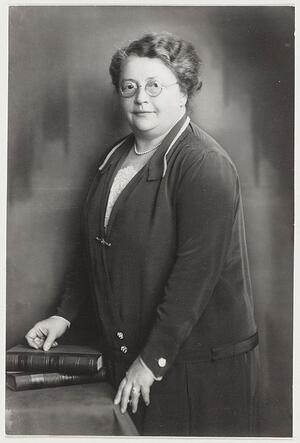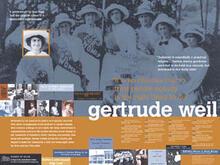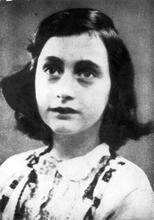Rosa Manus
Rosa Manus, a leader of several feminist and pacifist organizations in the Netherlands, 1928. Photograph by Jacob Merkelbach. Source: Beeldebank Stadsarchief Amsterdam, via Wikimedia Commons.
From early on, Rosa Manus wished to escape her traditional bourgeois upbringing in Amsterdam, attending meetings of the International Woman Suffrage Alliance, where she met influential suffragettes Carrie Chapman Catt and Aletta Jacobs. In 1915 helped to organize the International Women’s Conference against War. Manus would remain committed to the causes these organizations represented—women’s suffrage and pacifism—for the rest of her life, serving in leadership positions of various organizations and founding others. Increasingly angered by the reluctance of the Dutch women’s movement to recognize antisemitism in Europe, Manus distanced herself from the movement in the 1930s. In 1940 she was arrested and deported to Ravensbrück, then sent to Bernburg, where she was gassed in 1943.
Although Rosa Manus was one of the leading Dutch feminists prior to World War II, her memory has long been overshadowed by more famous contemporaries, such as Aletta Jacobs. This situation is changing, however, mostly due to the laborious work of her biographer, Myriam Everard. Rosa Manus’s life was interwoven with pacifism, the struggle against fascism, and the destruction of Dutch Jewry. More than other feminists, she suffered from the difficult position in which Jews were placed following the rise of fascism in Germany, when many women’s organizations were anxious to avoid being perceived as too Jewish. Carrie Chapman Catt, who regarded Manus as a pupil, assistant, and adopted daughter, remembered her as one of the first to die for “the cause,” ignoring the fact that Rosa Manus had been arrested for her pacifist activities and deported as a Jew. Indeed, although her name appears on the memorial to those who died in Ravensbrück, several witnesses testified to her having been deported, gravely ill, to Bernburg, where she was gassed. Myriam Everard has succeeded in digging up this history.
Early Life and Feminist Activism
Rosa Manus came from a prosperous bourgeois Jewish family. Her father, Philip Manus, was a tobacco merchant and her mother, Soete Vita Israel, was a homemaker born in the Netherlands. Rosa was the second of their seven children. From an early age, she longed for independence, education, and paid employment—aspirations that had no place in the environment in which she grew up. Even her desire to become a nurse was not supported. Instead, she took up philanthropy and sat upon various charitable committees.
In 1908, during the Congress of the International Woman Suffrage Alliance (IWSA), Manus met and formed friendships with Aletta Jacobs and Carrie Chapman Catt. From then on, she became increasingly well known as a feminist, partly through organizing the 1913 exhibition “De Vrouw 1813–1913,” which portrayed the life of Dutch women. The following year, she and Jacobs attended the conference of the International Woman Suffrage Alliance in London. In 1915, as an extension of this event, Manus helped set up the International Women’s Conference against War, organized by the Women’s International League for Peace and Freedom (WILPF).
Women’s Suffrage and Pacifism
From then on, Manus’ life followed two distinct paths: women’s suffrage and pacifism. Both paths were marked by lifelong friendships within a large network of politically active women, including Rosika Schwimmer, also a friend of Aletta Jacobs. In 1923, Manus accompanied Chapman Catt on a journey abroad, during which they witnessed the rise of fascism in Rome and visited Vienna, Budapest, and Czechoslovakia. In 1926, she became Secretary of the Peace Committee of the International Alliance of Women (formerly the IWSA), becoming Vice-President later the same year.
Manus was also active on a national level, both in the Dutch branch of the IWSA and as the founder of the Dutch Electoral Association for Women in 1932. In 1935, she was the driving force behind the establishment in Amsterdam of the International Archives for the Women’s Movement (IAV), the aim of which was to promote the knowledge and scientific study of the women’s movement and to be a center for collecting and preserving the cultural heritage of women. (On July 2, 1940, the Germans removed its entire contents. The Archives reopened after the war; only in January 1992 did a Dutch historian discover some of its contents in Moscow.) Less known is Manus’ 1938 involvement in the beginning of the Amsterdam Auxiliary Corps, an organization of women volunteers.
Given the constant threat of war, it was inevitable that Manus would become increasingly involved in the cause of pacifism. In 1932, she was partly responsible for the eight million signatures against war presented at the Geneva Disarmament Conference. She was also active in the Women’s Disarmament Committee of International Organizations. In 1936, as assistant to Lord Robert Cecil (who received the Nobel Prize for Peace in 1937), she was prominent in the Congrès du Rassemblement Universel pour la Paix, in Brussels.
Growing Marginalization
Manus’ involvement in the pacifist movement garnered her a reputation as a left-winger, which at the time was not an asset in feminist organizations. The aim in those days, at both the national and international level, was to give a neutral impression, one that was not too Jewish and certainly not too leftist. On a number of occasions, Manus was cruelly undermined and, as a result, withdrew from the national level of Dutch feminism, incensed by the movement’s silence and its refusal to recognize the difficult position of Jews. These were expressed in an ambivalence towards her and other women who had contributed greatly to feminism: on the one hand, there was fear of being viewed as a movement dominated by Jewish women, and on the other, a fear of being seen as antisemitic. Although she never said so explicitly, Manus’ position had become untenable. The same applied to other leading Jewish feminists.
In 1939, during an IAW conference in Copenhagen, Manus clashed with the Egyptian representative, Hoda Charaoui. She described the episode in a letter to Catt. A proposal to allow no more Jews into Palestine was under discussion, which she regarded as inconsistent with the fact that the Union of Hebrew Women for Equal Rights in Erez Israel was a member of the IAW and participated in the conference. Although she was re-elected to the Committee of the IAW and remained in the organization, her letter exhibits traces of bitterness.
Rosa Manus was a person living in an antisemitic world that grew increasingly dark. She did not shed her Jewish identity, but rather utilized feminism as a path to integration and as a bridge to traverse the borders of traditional Jewish femininity. The nineteenth-century “Moment of Assimilation,” as Paula Hyman termed it, had introduced new standards of behavior for Jewish women. In a world of change, we can trace the emergence of a modernized vision of Jewish family life. The role of women was articulated within the discursive framework of new values, where women were called to play a more significant role. Still, they remained confined to the boundaries of their background. And, being a Jew, Manus remained an outsider.
Deportation and Death
Rosa Manus had no illusions. Her friends and family were already being affected by Nazism, and she expected the situation of Jews to get worse. Through the National Women’s Committee for Refugees, she was active in helping the stream of German refugees and set up a center for refugee women. Her growing unease was justified, as was her assumption that she would be picked up soon after an invasion of the Netherlands. Already suspect as a pacifist and because of her international contacts, she was arrested in 1940. As a Jew, she could expect no special treatment and, after a short spell in prison, she was deported to Ravensbrück, and from there she met her final destiny.
Everard, Myriam. “Rosa Manus: The Genealogy of a Jewish Dutch Feminist.” In Rosa Manus (1881-1942): the international life and legacy of a Dutch feminist, edited by Myriam Everard and Francisca de Haan. Leiden, Boston: Brill, 2016.
Leydesdorff, Selma. “Dutch Jewish Women. Integration and Modernity.” In Dutch Jewry in a Cultural Maelstrom, edited by Judith Frishman and Hetty Berg, 183-194. Amsterdam: Amsterdam University Press, 2007.
The papers of Rosa Manus are held by Atria, Institute on Gender Equality and Women's History in Amsterdam. With other archives, they were discovered in Moscow and were recuperated in 2003.





